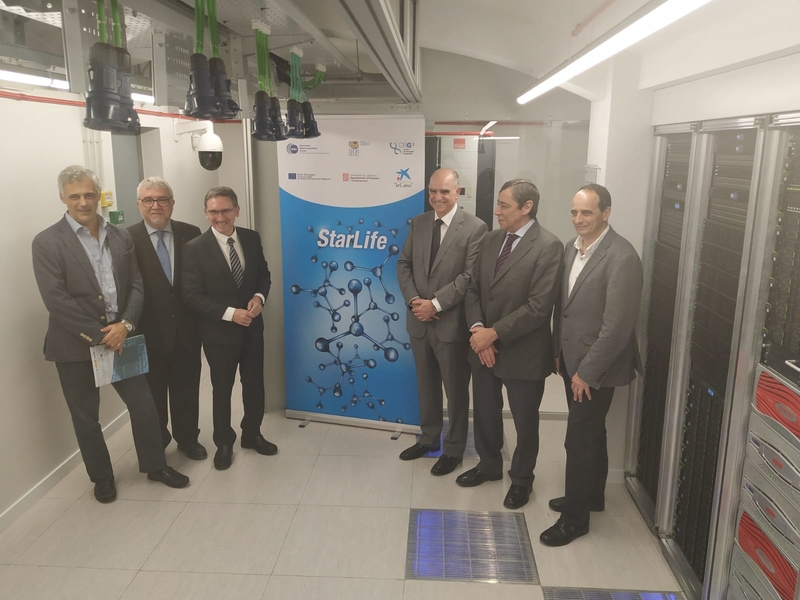The initiative is coordinated by Barcelona Supercomputing Center, the Centre for Genomic Regulation and IRB Barcelona.
Financial support has been provided by the Catalan Government with ERDF funds with the backing of ”la Caixa”.
It is designed to provide a high-performance service to meet the growing need to handle, analyze and store the vast amounts of data needed for biomedical research and personalized medicine.
Rafael Rodrigo, the president of the Barcelona Supercomputing Center (BSC) consortium and General Secretary of Scientific Policy Coordination at the Ministry of Science, Innovation and Universities; Francesc Posas, director of the Institute for Research in Biomedicine (IRB Barcelona); Luís Serrano, director of the Centre for Genomic Regulation (CRG); Sergi Girona, BSC's operations director; Jaume Giró, general manager of “la Caixa” Banking Foundation; Francesc Xavier Grau, Catalan Government Secretary for Universities and Research, and Mateo Valero, BSC's director, today presented StarLife, new IT infrastructure designed to boost and serve biomedical research of excellence and precision medicine. StarLife is an initiative coordinated by BSC, CRG and IRB Barcelona and has financial support from the Catalan government with ERDF funds and ”la Caixa”.
Key to genomics and personalized medicine
StarLife is a computational infrastructure for large-scale biomedical projects that require an architecture designed specifically to handle and make use of vast volumes of biomedical data.
Hospitals and biomedical research centers are generating ever greater amounts of molecular and omic data, medical images, data from medical devices and clinical histories which, in terms of their amount and complexity, are equivalent to those generated in other knowledge areas such as astronomy and meteorology.
Interpreting these data and integrating them in simulation environments is essential in order to progress in developing biomedical research and personalized medicine, including understanding how living organisms work, drug development and disease treatment.
StarLife will make it possible to implement more advanced computation techniques, such as those used to detect new genes related to diseases such as cancer and minority diseases, as well as simulating the behavior of molecules in order to speed up drug discovery.
A step forward resulting from collaboration in ongoing research
StarLife has sprung from the ongoing collaboration between BSC, CRG and IRB. Since 2014, these organizations have shared a Joint Computational Biology Program, i.e. the use of computer tools applied to the field of biology. Their collaboration includes genome analysis and sequencing, biomolecule modelling, evolution studies and the creation of phylogenetic trees, etc.
“The scale and flexibility of the new equipment will make it possible for scientists from the promoting institutions to conduct cutting-edge research”, said Luis Serrano, CRG's director. “In addition to being infrastructure that will provide a service to researchers all around the world through the European Genome-phenome Archive (EGA), https://ega-archive.org/), StarLife is the main global center for storing and distributing genomic and medical data concerning human diseases”, he concluded.
"The StarLife equipment is a turning point in our research and consolidates the centers we have promoted as global leaders in the field of biomedicine," according to Francesc Posas, the director of IRB Barcelona. "At IRB Barcelona we will use it to work on the molecular structure of DNA and cancer genomics with a focus on developing personalized medicine."
A flexible system complementing the MareNostrum supercomputer
StarLife is a computation and storage system with a calculation capacity of 132.8 teraflops (133 trillion operations per second), a storage capacity of 9.5 petabytes (10 million gigabytes) and 9.1 terabytes (9,100 gigabytes) of RAM.
“Its main feature is that it can easily be reconfigured and adapted to the various needs of different biomedicine-related tasks, which include execution in a high-performance computing environment, the cloud and big data analysis”, explained Sergi Girona, BSC's director of Operations, "and when we conduct very specific analyses with a great need for supercomputing, we have the MareNostrum supercomputer.”
Possible thanks to public-private support
StarLife has cost €1.72 million, 43% of which was provided by the Catalan government with ERDF funds, 22% by ”la Caixa” and the remaining 35% is a joint investment by BSC, CRG and IRB Barcelona.
Rafael Rodrigo, the General Secretary of Scientific Policy at the Ministry of Science, Innovation and Universities highlighted “the Spanish government's commitment to science and innovation in general and supercomputing and biomedicine in particular. StarLife is without doubt a project of great interest that will undertake biomedical projects in Catalonia, a leading region in RDI. And it will do so through public authorities, research centers of excellence with a global reputation and an institution that has always been committed to science: “la Caixa” Banking Foundation. This project is a great opportunity that will allow us to keep making progress in the field of health.”
Francesc Xavier Grau, the Catalan Government Secretary for Universities and Research, said: "This infrastructure, which is being set up thanks to the collaboration of key players in our system of knowledge and the Catalan government with European and private funds is a response to a growing need: managing the data generated in biomedical research to bring about an effective impact on the population's health. Catalonia must be prepared, as a leading country in biomedical research, to turn the clinical and healthcare opportunities of personalized medicine into reality. We have the infrastructure. Storing and making proper use of health data is essential."
According to Jaume Giró, general manager of “la Caixa” Banking Foundation: “It is an example of public-private institutional architecture to boost international research of excellence to improve people's health to which we are proud to contribute. Research is one of the priority areas in “la Caixa” Banking Foundation's strategic plan, in which we have invested €90 million.”
StarLife is physically located in Barcelona Supercomputing Center's facilities and, with complementary functions, it is incorporated in the integrated computational ecosystem that the MareNostrum 4 supercomputer is also part of.
Further information:
BSC: Gemma Ribas. Tel 34 675 78 59 75 / communication@bsc.es
CRG: Glòria Lligadas. Tel. 34 93 316 01 53 / 608 550 788 / gloria.lligadas@crg.eu
IRB Barcelona: Nahia Barberia. Tel 93 403 45 69/ 652769748/ communications@irbbarcelona.org
”la Caixa”: Irene Roch. Tel. 93404 60 27/669 45 70 94/ iroch@fundaciolacaixa.org





